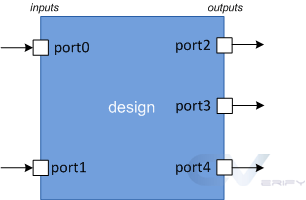Verilog 端口
端口是一组信号,它们充当特定模块的输入和输出,并且是与其通信的主要方式。将模块视为放置在 PCB 上的制造芯片,很明显,与芯片通信的唯一方法是通过其引脚。端口就像引脚,被设计用来发送和接收来自外界的信号。
<无脚本>
端口类型
| 端口 | 说明 |
|---|---|
| 输入 | 设计模块只能使用其input从外部接收值 港口 |
| 输出 | 设计模块只能使用其output向外部发送值 港口 |
| 输入输出 | 设计模块可以使用其inout发送或接收值 港口 |
默认情况下,端口被视为 wire 类型的网络 .
语法
声明为 inout 的端口 既可以作为输入也可以作为输出。
input [net_type] [range] list_of_names; // Input port
inout [net_type] [range] list_of_names; // Input & Output port
output [net_type] [range] list_of_names; // Output port driven by a wire
output [var_type] [range] list_of_names; // Output port driven by a variable
示例
在下面显示的代码中,有三个input 端口,一个 output 端口和一个 inout 港口。
module my_design ( input wire clk,
input en,
input rw,
inout [15:0] data,
output int );
// Design behavior as Verilog code
endmodule
使用相同的 name 是非法的 用于多个端口。
input aport; // First declaration - valid
input aport; // Error - already declared
output aport; // Error - already declared
签名端口
signed 属性可以附加到端口声明或 net/reg 声明或两者。隐式网络默认为 unsigned .
module ( input a,
b,
output c);
// ports a, b, and c are by default unsigned
endmodule
如果 net/reg 声明中的任何一个具有 signed 属性,则另一个也应视为已签名。
module ( input signed a, b,
output c);
wire a, b; // a, b are signed from port declaration
reg signed c; // c is signed from reg declaration
endmodule
端口变化
Verilog 1995
Verilog经过多次修改,1995年的原始IEEE版本有以下端口声明方式。在这里,模块声明必须首先在括号中列出端口的名称,然后在模块主体中列出这些端口的方向。
module test (a, b, c);
input [7:0] a; // inputs "a" and "b" are wires
input [7:0] b;
output [7:0] c; // output "c" by default is a wire
// Still, you can declare them again as wires to avoid confusion
wire [7:0] a;
wire [7:0] b;
wire [7:0] c;
endmodule
module test (a, b, c);
input [7:0] a, b;
output [7:0] c; // By default c is of type wire
// port "c" is changed to a reg type
reg [7:0] c;
endmodule
Verilog 2001 起
ANSI-C 风格的端口命名是在 2001 年引入的,允许在端口列表中指定类型。
module test ( input [7:0] a,
b, // "b" is considered an 8-bit input
output [7:0] c);
// Design content
endmodule
module test ( input wire [7:0] a,
input wire [7:0] b,
output reg [7:0] c);
// Design content
endmodule
如果端口声明包括网络或变量类型,则认为该端口已完全声明。在 net 或变量类型声明中重新声明相同的端口是非法的。
module test ( input [7:0] a, // a, e are implicitly declared of type wire
output reg [7:0] e );
wire signed [7:0] a; // illegal - declaration of a is already complete -> simulator dependent
wire [7:0] e; // illegal - declaration of e is already complete
// Rest of the design code
endmodule
如果端口声明不包括网络或变量类型,则端口可以再次在网络或变量类型声明中声明。
module test ( input [7:0] a,
output [7:0] e);
reg [7:0] e; // Okay - net_type was not declared before
// Rest of the design code
endmodule
Verilog


